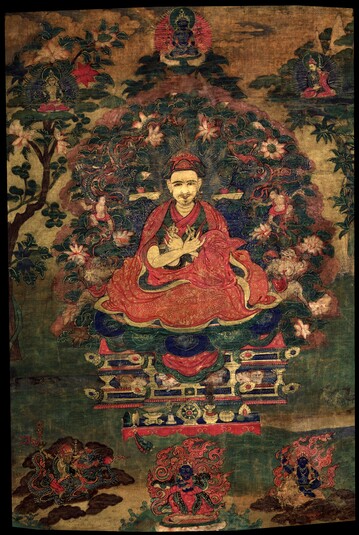
Item: Teacher (Lama) - Wangdu Nyingpo, Sakya Tridzin 32
| Origin Location | Tibet |
|---|---|
| Date Range | 1700 - 1799 |
| Lineages | Sakya and Buddhist |
| Material | Ground Mineral Pigment on Cotton |
| Collection | Rubin Museum of Art |
| Catalogue # | acc.#C2001.3.5 |
Wangdu Nyingpo, Tuchen (c.1763-c.1806): Patriarch of the Khon Family, the 32nd Sakya Tridzin, and also commonly known as the second Padmasambhava of this Age. He was a renowned Tantric practitioner and Terton - finder of Revealed Treasure. As a Tantric figure he was so popular that guruyoga practices were written that focused solely on him as a semi-wrathful mantradharin. (See the Wangdu Nyingpo Main Page).
Wangdu Nyingpo sits wrapped in a meditation cloak with only his face, upper torso and arms exposed. Atop the head is a small version of a sparsely ornamented mostly plain lotus hat. He has open eyes, dark eyebrows, mustache and a light beard, along with small earrings. the two hands grasp a vajra scepter and vajra handled bell in the 'vajra embracing' gesture in front of the heart. A white lower robe is partially exposed, tied with a black sash and holding a ritual peg (purba). Seated atop a blue and green lotus above a lion supported jeweled throne, he is surrounded by an elaborate back rest of foliage and flowers encircle by an decorative 'torana' of a lion, sharabha, boy and dragon on both the right and left sides of the throne. The two dragons each offer a bowl of green and red coloured wish-fulfilling jewels.
There is no name inscription, or any inscriptions, on the front or back of this painting. The identification of the central figure as Wangdu Nyingpo is based on the portrait of the figure and other comparable paintings and sculpture of Wangdu Nyingpo.
"To the buddhas of the three times as the second Oddiyana, Protector with all gathered power over the animate and inanimate, Subduer of wrong doers, possessing the essence of the path entwined as the great bliss of the four joys together with wisdom, compassion and power. I pray, pacify obstacles of daemons and bhutas, and bestow the blessing of attainments - making aspirations spontaneous." (Dragshul Trinley Rinchen, 1871-1935).
The two present day palaces (Tibetan: pho drang) of Sakya and branches of the Khon family, the Drolma and Puntsog, were founded by the two sons of Wangdu Nyingpo, Padma Dudul Wangchug and Kunga Rinchen respectively.
The red table with a blue surface in front support a double sided drum, teacup, vajra scepter, vajra handled bell, Dharma wheel, initiation vase, incense bowl, and three wish-fulfilling jewels.
At the top center is Samantabhadra, the primordial Buddha of the Nyingma Tradition of Tibetan Buddhism. He is blue in colour and wears jewel ornaments and heavenly garments. In the two hands placed in the lap in a gesture of meditation he holds the stems of two flowers blossoming at the right and left sides of his upper body. The two flowers support a vajra scepter on the proper right and a bell on the left.
At the upper left of the composition is the deity Vajrasattva, peaceful in appearance, holding a vajra scepter to the heart with the right hand and a bell upturned at the hip with the left hand. On the upper right side is Padmasambhava wearing a red lotus hat and holding a vajra scepter in the right hand and a skull bowl in the left.
At the bottom center is the wisdom protector deity, Sadhu Mahakala (Gonpo Legden), wrathful in appearance, blue in colour, holding ba hook knife in the right hand and skullup in the left. A long sandalwood staff rests against his right shoulder.
At the bottom left side is the wealth deity, White Jambhala, with one face and two hands, riding atop a turquoise dragon. On the right side is a wrathful female protector figure, likely to be Ekajati, with one face and two hands, riding atop a donkey. In the right hand she holds a loft a hooked knife and in the left she supports a white skullcup at the side.
The back of the painting has a drawing of the front figure but with the back turned to face the viewer. (See reverse of painting).
The 69th Abbot of Ngor Evam Choden Monastery, Ngagwang Yontan Gyatso (1902-1963), was believed by some to be an incarnation of Wangdu Nyingpo, as is the current Sakya Tridzin, Ngagwang Kunga (born 1941).
Jeff Watt [updated 1-2013]
Tradition: Nyingma Teachers (Paintings)
Collection of Rubin Museum of Art (RMA): Main Page
Teacher: Wangdu Nyingpo (Sakya Tridzin)
Tradition: Sakya Portrait Teachers (Rubin Museum)



